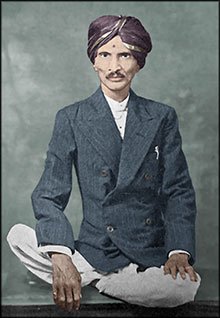 Wisdom of Sri Gajanana Maharaj of Nashik
Wisdom of Sri Gajanana Maharaj of Nashik
Now let us see how a man should act in worldly life so that he may progress spiritually while leading a life of the world.
To him I will say, “My good friend, continue to do your worldly duties as you are doing now. Only begin the practice of Dhyana Yoga and carry it on and stick to it with perseverance. You can thus kill two birds with one stone. You will be able to lead a worthy worldly life and also to progress spiritually. Try it and you will be convinced of the truth of what is said above from your own experience.”
Now let us see how this can be accomplished. No human being can ever escape from the necessity of doing actions. There are, however, two different ways of doing these actions. In the one, we do all actions with the desire of achieving some object as a consequence of those actions. If our object is fulfilled, we become happy and full of joy. If, on the contrary, we fail in achieving our object and are unsuccessful, we are cast down and we become full of sorrow. Thus we see that the real cause of our happiness or sorrow is not the actions themselves, but the object or motive behind them. If we then abandon the object and do not pay any attention at all to the consequences of our actions, but do them from a sense of duty only, we shall never fall into the clutches of sorrow and our peace of mind will never be disturbed. Actions done with the desire of achieving some object are known as sakama and those done merely from a sense of duty without any object in view are known as nishkama.
Now if we cast a glance at the worldly experiences of our own and of others, what do we see? Do we find that all our actions are successful and that our desires are in every case fulfilled? Do the actual results of our actions correspond to the expectations entertained in our mind regarding them? No. On the contrary, we find that in the majority of cases we are unsuccessful and have to swallow the bitter pill of disappointment. There are various obstacles which intervene and frustrate our desires. We sometimes overcome some expected obstacles and triumph over the difficulties. But almost always we succumb before unexpected obstacles and difficulties. In such circumstances we get confounded, and getting submerged in the slough of despondency are completely at a loss to know what do. We are sometimes quite tired with our life and wish that it were ended. Why is it so? It is because when we do actions with some object in view, all our attention is directed towards the object, and once that is frustrated the equanimity of the mind is entirely disturbed and we become a prey to sorrow and despondency.
If on the other hand we do actions merely from a sense of duty without paying any attention to the result, and taste the fruit of those actions quite naturally as it comes, we shall not be affected either by joy or sorrow and our peace of mind will never be disturbed. This is because vasana (desire) which is the root cause of all sorrow is nullified. To do actions in this manner is known as Nishkama Karma Yoga. If a person follows this method while leading his life in the world he will surely attain Self-realization. Such a person need not renounce the world. Only he must follow this method with great perseverance and firm determination. He must only have the will to do so, and his efforts will surely be crowned with success.
All actions, therefore, which are done by us without any desire of obtaining the fruit, and simply from a sense of duty, are nishkama Such a person is known as a Nishkama Karma Yogi. He easily achieves success in spiritual matters, and in course of time attains the bliss of the Self.
I therefore humbly request you all: Think of all things with an independent and unbiased mind, through practice root out all likes and dislikes and acquire a sense of complete detachment. With Nishkama Karma Yoga carry on your worldly duties and through meditation and practice become one with the universe and enjoy everlasting bliss.
For unknown words, see A Brief Sanskrit Glossary on our website.
NOTE: Atmaprabha, from which this blogpost is taken can be found in Appendix One of our publication Soham Yoga. Other teachings of Sri Gajanana Maharaj can be found in Chapter Three of Soham Yoga.







